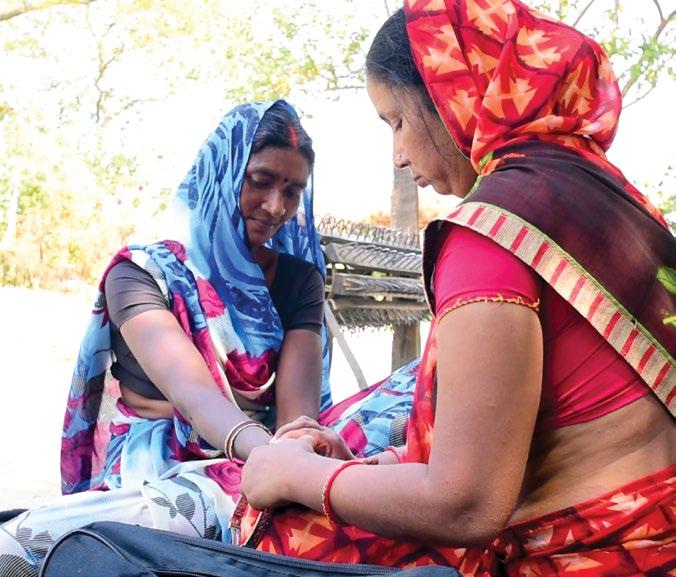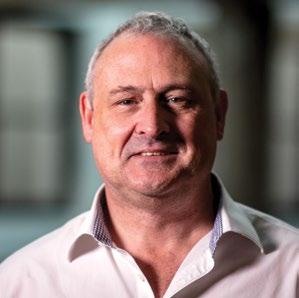
6 minute read
Bridging India’s healthcare gap
FEATURE | INDIA Bridging India’s healthcare gap
Training women to work as Basic Care Providers in rural villages in India’s north, is bridging a massive gap between people living in poverty and the health care they desperately need.
Awheat thresher makes a unique sound. A whirring, whistling of the spinning cylinder mixed with the chugging of an old engine and a flapping flimsy belt that connects the two. The large cylinder is held by fencing wire, suspended horizontally between two worn wooden posts, its raised metal hooks ripping grain from stalks as it reaches speed and the grain stalks are forced down upon it. Apart from the engine, the apparatus is mediaeval in appearance. The family moves in with bundles of wheat, holding them tightly as they force the heads of grain onto the machine, flipping the bundles over and sliding them back and forth, forwards and backwards, making sure every grain is pulled from the stalk. It is quick work, but the danger is obvious: a slip, a moment’s inattention, a loose piece of clothing could end in catastrophe. The hospital, emergency medical care, transport, are a long way away. It is in this setting, in rural Uttar Pradesh, India, that Usha Devi finds herself. Usha is a BCP—a Basic Care Provider—not quite a paramedic or nurse, but more than a first aid responder. BCPs provide an essential health service to people living in rural India. “In a village, a BCP is required because emergency facilities cannot be found,” Usha said. “If anything happens, a BCP can be found immediately in the village and any primary treatment can be easily provided by the BCP.” Like all BCPs, Usha’s health journey began as a Community Health Facilitator or CHF, commonly known as community health leaders. But Usha’s journey with Opportunity began even earlier – Usha and her husband were microfinance clients, having taken a small loan for their electronics business selling cameras and video equipment and some whitegoods.
We were able to do decent work, our children also started studying…it [the small loan] was important for the children’s school admission,” she said. “Now our economic condition has become very good.”
Through the loan process, Usha heard about the health leader program. CHFs learn about general health care including clean water, sanitation and
Usha examines a patient, Uttar Pradesh, India. © Matthew Smeal
hygiene; nutrition, and menstrual hygiene. Following the training, the health leaders visit different villages, giving talks to the community and spreading good health messages and education. Some also become health entrepreneurs, selling items like soap and sanitary napkins, making a little money and alleviating the need for villagers to spend time and money travelling to larger towns to buy such items. Other health leaders, like Usha, become BCPs. Training people to become Basic Care Providers was a new concept and Usha was in the first batch. “Because everyone was from three places it all felt very different. But slowly, as we started meeting regularly, it became like a family,” she said. The training has taken place over three years—three or four days each month— and while basic, it is comprehensive. “The training was on the nervous system, breathing system, digestive system, cuts and bruises etc.,” Usha said about the
Bridging India’s healthcare gap
training which covers 12 modules about the body and its various systems. Her role now is to visit different villages to check on people’s health and be the first point-of-contact if someone may have something more serious. “In the community we see mostly women with leg pain, back ache, and urine problem…and itching in the body [skin infections] and also diarrhoea,” Usha said. “In many areas it is dirty; eating habits are bad…some don’t maintain cleanliness.” When seeing a patient, Usha checks the usual signs: blood pressure, heart rate, blood oxygen levels, temperature. In matters of basic care, Usha can assist the patient and suggest ways for them to regain health. But if things aren’t normal, Usha is able to refer them to a doctor. To help her navigate that path, Usha has a significant helping hand: technology – more specifically, a tablet. By typing in symptoms and other health information she receives from the patient, the tablet prompts Usha for specific information and begins narrowing down potential problems and lets Usha know if anything is missing. That’s why the tablet is important, if any mistake is made, it promptly tells what information has not been added,” she said. “When we add information in, if we need it again, we can see the information.” The tablet is a good sense check but also a reassurance to BCPs who need to know when to refer a patient on to a higher level of care. Usha mentions a baby girl whom she immediately referred to hospital with a kidney infection and also a villager with a severe cut which she treated at the scene and arranged for them to get further care. Sometimes the treatment can go against traditional practices. Sometimes, the treatment can also be very close to home. “It happened to my son,” Usha said.
STAFF PROFILE
Mark Daniels is the Asia Programs Director for Opportunity International Australia.
After leaving the accounting world, Mark Daniels went in search of something different. He backpacked around the world solo for 14 months and fell in love with Asia. It was there that Mark first heard about microenterprise development. “I thought if I could combine my skills of accounting with helping people, that would be great. Fortunately, I managed to get work with Opportunity back in 1998 as a Project Officer,” Mark said. “When you serve the poor, you are walking on sacred ground. Gaining a deeper understanding of the behavioural economics has been a fascinating and enriching journey.” As one of Opportunity’s longest standing staff members, Mark has more than two decades of experience in international finance, philanthropy and non-profit development – 10 of those years spent living and working in the Philippines. Today, Mark oversees Opportunity’s programs in India, Indonesia and Bangladesh which have evolved to address the health, education and safety needs of the people we serve. “Microfinance is simply one tool in the poverty alleviation toolbox, given its multidimensional nature,” Mark said. “The poor need both financial and nonfinancial services to advance.” “The microfinance client base provides a great distribution network to those
“He hurt his leg. I was giving him RICE (Rest, Ice, Compression, Elevation) therapy. Lots of people told me to massage the area but I explained that is not what I am doing, that I was giving RICE therapy and then I would take him for an x-ray because it was so painful.” Thankfully, Usha’s son had only suffered a sprain but seeing a BCP working with knowledge and confidence helps her build trust and acceptance within the communities she visits. It has also done the same in her own home.
Mark Daniels, Opportunity’s Asia Programs Director. in poverty, by which you add on interventions through an ecosystem of partnerships i.e. health with the ultimate aim to build household sustainability.”
HOUSEHOLD SUSTAINABILITY HAS THREE STAGES:
1. Stabilisation – where the aim is to minimise risks to prevent slide back into poverty. Savings and insurance are critical to protect against shocks, such as natural disasters and illness. 2. Maintenance – where stability is maintained, and surpluses converted into assets and investments. This usually requires improvements in health, education, livelihood skills and financial literacy. 3. Self-sufficiency – where the household is resilient and moving out of poverty. “What I love about Opportunity is that I often say, ‘we are the only charity that gives nothing away’,” Mark said. “We help individuals with loan capital and then usually poor women use their own sweat equity to create their own economic choices and future.”

To see patients, Usha often needs to travel up to 20km. Nowadays, she usually travels on the back of her husband’s motorcycle. Many Indian men restrict their wives’ independence and while Usha’s husband was initially sceptical, he has become so proud of his wife’s achievements that he now drives her from village to village so she can complete her work – a tremendous example of the empowerment that the BCP training provides.







